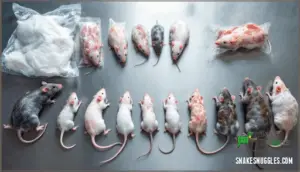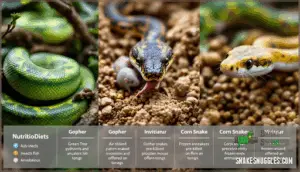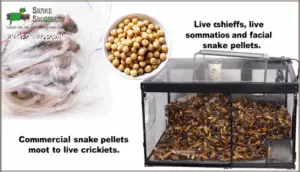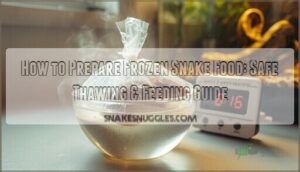This site is supported by our readers. We may earn a commission, at no cost to you, if you purchase through links.
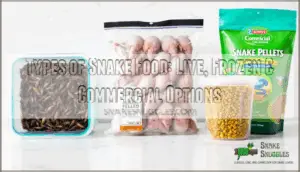
Some species thrive on a mix of rodents and birds, while others need invertebrates or aquatic prey to stay healthy. Commercial diets now pack balanced nutrition into convenient forms, making feeding safer and simpler.
Knowing the right options for your snake’s species, size, and habits gives you control over their well-being and peace of mind at every feeding.
Table Of Contents
Key Takeaways
- Choosing snake food depends on your species’ natural diet, with options ranging from rodents and birds to fish, invertebrates, and small mammals.
- Rotating prey types and matching food size to your snake’s girth helps prevent nutritional gaps and health problems.
- Frozen-thawed and pre-killed prey are safer and more convenient than live feeding, reducing injury and disease risks.
- Commercial diets like freeze-dried prey, pellets, and formulated sausages offer balanced nutrition but should be selected carefully to match your snake’s specific needs.
Common Types of Snake Food
When you’re choosing food for your snake, you’ll need to understand what prey types match your species’ natural diet. Most captive snakes thrive on rodents, but some species require birds, fish, invertebrates, or other mammals to meet their nutritional needs.
Let’s look at the main prey categories you’ll encounter as a snake keeper.
Rodents (Mice, Rats)
Mice and rats form the backbone of most captive snake diets, representing an estimated 85 million to 2.1 billion vertebrates fed annually to pet snakes worldwide. These rodents provide complete nutrition when properly selected and stored. You’ll find them available as live prey, frozen prey, or pre-killed options from commercial suppliers.
Key considerations for rodent feeding:
- Match prey sizing to your snake’s girth—the rat or mouse should be no wider than the snake’s thickest body point
- Rotate between mice and rats to support nutritional balance and prevent vitamin E or selenium deficiencies
- Store frozen rodents properly to maintain rat health value and prevent rancid oils that cause fat necrosis
- Source from reputable mouse breeding operations to guarantee consistent rodent nutrition and minimize disease risk
Birds (Chicks, Quail)
Beyond rodents, chicks and quail offer valuable dietary variety for many snake species, particularly those that naturally hunt avian prey in the wild. Day-old chicks provide soft bones and concentrated nutrients, while quail feeding introduces different protein profiles that help prevent vitamin E deficiencies common in monotonous diets.
| Prey Type | Best For | Nutritional Benefit |
|---|---|---|
| Day old chicks | Larger constrictors, king snakes | High protein, calcium-rich bones |
| Quail chicks | Medium pythons, boas | Balanced fat-to-protein ratio |
| Quail eggs | Small colubrids, hatchlings | Gentle introduction to fowl alternatives |
| Adult quail | Large pythons, monitor feeders | Dense nutrition, feather content |
| Young birds (mixed) | Species-specific rotation | Prevents nutrient imbalances |
Rotate poultry options with rodents every third or fourth feeding to optimize bird nutrition benefits without disrupting your snake’s established feeding response.
Fish and Aquatic Prey
For aquatic and semi-aquatic species like garter snakes and water snakes, fish represents a natural prey base that triggers strong feeding responses—but choosing the right fish matters more than most keepers realize. Goldfish and shiners contain thiaminase, an enzyme that destroys vitamin B1 and causes neurological damage in piscivorous snakes.
Your aquatic snake diet should include thiaminase-free fish species like salmon, trout, or tilapia—available as frozen prey from reptile food suppliers. Rotate fish with other water prey to prevent the nutritional deficiencies that plague monotonous aquatic feeding programs.
Invertebrates (Worms, Insects)
Smaller species like ringneck snakes, smooth green snakes, and juvenile garters rely on invertebrate prey—earthworms, slugs, and soft-bodied insects—that larger constrictors would ignore entirely. Wild-caught invertebrates carry parasite risks, so invertebrate breeding programs or reputable feeder insects from reptile food suppliers offer safer alternatives. Insect nutrition varies markedly by species:
- Earthworms: High moisture content, ideal for garter snakes
- Nightcrawlers: Larger worms for growing juveniles
- Slugs: Natural prey triggering strong feeding responses
- Soft-bodied insects: Crickets and roaches for smaller carnivorous animal diets
- Exotic inverts: Dubia roaches provide excellent worm feeding nutrition
Rotate snake prey options to prevent nutritional gaps in invertebrate-dependent species.
Mammals (Rabbits, Guinea Pigs)
Large constrictors and heavy-bodied snakes eventually outgrow rodents, turning to rabbits, guinea pigs, and other small mammals that provide the caloric density needed for species weighing several kilograms. Reticulated pythons, Burmese pythons, and large boas thrive on rabbit nutrition and guinea pig care protocols that mirror natural mammal feeding patterns.
Prey size matching remains critical—select mammals appropriate to your snake’s girth to prevent regurgitation or impaction.
| Prey Type | Ideal Snake Species | Nutritional Benefit |
|---|---|---|
| Rabbits | Reticulated pythons, anacondas | High caloric density, substantial muscle mass |
| Guinea Pigs | Burmese pythons, large boas | Balanced fat-to-protein ratio for growth |
| Small Mammals | Adult blood pythons, African rock pythons | Furry prey texture triggers feeding response |
Live Vs. Frozen Snake Food
When you’re deciding how to feed your snake, you’ll face a fundamental choice between live prey, frozen-thawed options, and pre-killed alternatives. Each approach comes with distinct advantages and risks that directly affect both your snake’s health and your safety during feeding time.
Let’s break down what you need to know about these different feeding methods.
Pros and Cons of Live Prey
Live prey might seem like the most natural choice, but it’s a decision that carries both benefits and serious risks you’ll need to weigh carefully. While live prey triggers natural hunting instincts and provides enrichment, prey management mistakes can result in serious injuries to your snake. Wild-caught prey may carry parasites or diseases, making commercially raised options safer for snake nutrition.
Snake feeding methods using live versus frozen prey remain debated among keepers, but snake diet considerations should prioritize your animal’s safety alongside feeding techniques that minimize stress for both predator and prey.
| Aspect | Advantages | Disadvantages |
|---|---|---|
| Behavioral | Stimulates natural hunting instincts | Risk of prey biting or scratching snake |
| Nutritional | Fresh, unprocessed nutrients | Potential disease or parasite transmission |
| Practical | May entice reluctant feeders | Requires careful supervision during feeding |
Benefits of Frozen-Thawed Prey
With frozen-thawed prey, you get a safer, more convenient way to feed your snake while keeping mealtime predictable for you both. Frozen prey reduces the risk of parasite transmission and injury, retains nutrients well, and offers cost efficiency and ease of use that live prey can’t match.
| Benefit | Live Prey | Frozen-Thawed Prey |
|---|---|---|
| Safety Benefits | Low | High |
| Convenience Factors | Low | High |
| Nutritional Retention | Variable | Good |
| Cost Efficiency | Lower | Higher |
| Ease of Use | Difficult | Simple |
Pre-Killed Prey Options
Ever wondered if there’s a middle ground between the risks of live prey and the frozen convenience you’re used to? Pre-killed (dead) prey offers just that—blending safety in dealing with prey, consistent nutrient retention, and ethical considerations.
With straightforward thawing techniques and smart storage guidelines, feeding dead prey to snakes fits smoothly into any frozen food diet.
| Aspect | Pre-Killed Prey |
|---|---|
| Safety in dealing with prey | High |
| Nutrient Retention | Good |
| Thawing Techniques | Simple |
| Storage Guidelines | Easy |
| Ethical Considerations | Strong |
Safety Considerations
Imagine risking your snake’s life for a meal—prey injuries from live rodents cause emergency vet visits far too often. Secure practices and good storage habits don’t just prevent foodborne illness; they also shield your family from zoonotic risks.
Regarding snake feeding safety, understanding live vs frozen prey is the linchpin. Snakes benefit from being fed dead prey, as live prey poses risks of injury.
| Risk Factor | Frozen/Pre-Killed | Live Prey |
|---|---|---|
| Prey Injuries | Minimal | Significant |
| Zoonotic Risks | Lower | Higher |
| Storage Hazards | Manageable | Low |
| Bites | None | Common |
Commercially Manufactured Snake Foods
Commercially made snake foods give you another way to meet your snake’s dietary needs. They’re designed for convenience, safety, and balanced nutrition.
Here’s a closer look at the main options you’ll find on the market.
Freeze-Dried Prey
If you’re looking for easy storage and less mess when feeding your snake, freeze-dried prey might be just what you need. Here’s what to keep in mind:
- Nutrient Retention can vary compared to frozen prey.
- Rehydration Methods affect palatability.
- Storage Stability is a strong point.
- Palatability Concerns exist for picky eaters.
- Cost Analysis often favors convenience over savings.
Pelleted and Gel Diets
After freeze-dried options, you might notice pelleted and gel diets popping up as another simple way to feed your snake. These products offer Pellet Nutrition and Gel Feeding convenience, aiming for balanced reptile nutrition.
They can serve as a Meal Replacement or supplement, but always check labels for Dietary Variety. Not every species thrives on commercial snake food alone—know your snake’s carnivorous diet needs.
Formulated Sausage Diets
You’ll also find formulated sausage diets on the market, designed to mimic the nutrition of whole prey while offering an easy-to-serve option for keepers who want more control over their snake’s intake. Sausage Nutrition and Diet Formulation bring variety and convenience, supporting Snake Health. Consider these benefits:
- Easy portion control
- Reduced mess
- Consistent reptile nutrition
- Meat Alternatives for picky eaters
- Reliable carnivorous diet
Nutritional Completeness
While sausage diets offer control over portion and mess, you still need to check for Nutrient Balance and overall nutritional completeness. Commercial foods often include Vitamin Supplements and added minerals to meet snake dietary needs, but not all brands match the Dietary Needs of your species.
A balanced diet promotes ideal snake nutrition and helps avoid gaps in reptile nutrition over time. Proper reptile nutrition management involves understanding reptile dietary needs to guarantee the best care for your pet.
Species-Specific Snake Diets
Each snake species has its own dietary needs and preferences. What works for one type won’t always suit another.
Here’s a look at how diets vary across some of the most common pet snakes.
Diets for Corn Snakes
Corn snakes aren’t picky eaters by nature, but getting their diet right is the key to helping them thrive. Rotate rodent prey like mice for balanced Corn Snake Nutrition, sticking with frozen food diets when possible.
Regularly switch up prey size and type—this promotes snake food variety and covers their dietary needs. Supplements rarely matter if feeding guidelines are followed.
Diets for Ball Pythons
Ball pythons thrive on a steady diet of appropriately sized rodents, with feeding routines that reflect their slow metabolism and natural feeding habits. For healthy Ball Python Nutrition and peak snake health, focus on:
- Using frozen food over live prey to reduce stress and injury.
- Matching prey size to your python’s girth.
- Rotating prey types to meet dietary needs and prevent nutritional gaps.
Diets for Garter Snakes
For ideal Garter Snake Nutrition, rotate prey—minnows, earthworms, and the occasional frog—while steering clear of goldfish due to thiaminase risk. Prey Variety promotes a balanced snake diet and nutrition. Dietary supplements are rarely needed if snake food choices follow sound snake feeding guidelines and snake diet restrictions.
Feeding Techniques matter: offer food in a stress-free Snake Habitat, using tongs for hygiene.
Diets for Aquatic Snakes
For aquatic nutrition, you’ll want to offer a mix of safe fish diets—think smelt, silversides, or amphibians—while steering clear of goldfish and shiners due to snake diet restrictions.
Snake feeding for water prey requires variety to support piscivorous habits. Always rotate snake prey animals and monitor feeding pet snakes for signs of nutritional imbalance in your snake food choices.
Alternative and Supplemental Prey Choices
Feeding your snake isn’t just about sticking to one type of prey. Offering variety can help keep your snake healthy and interested in food.
Here are some alternative and supplemental options to explore for their diet.
Variety for Nutritional Balance
When you practice prey rotation and diet diversification, you help your snake achieve ideal nutrient balance. Dietary variety—mixing rodents, birds, fish, and invertebrates—sustains snake nutrition and balanced diets.
Feeding snakes variety isn’t just a luxury; it’s a necessity for long-term health. Alternative food choices guarantee your snake diet and feeding routine meets all essential needs.
Offering your snake a variety of food is essential for its long-term health and ensures all nutritional needs are met
Avoiding Monotonous Diets
Sticking to just one type of prey is like putting all your eggs in one basket—your snake’s health depends on mixing things up. Without diet variety and prey rotation, nutrient imbalances can creep in.
Feeding snakes alternative food guarantees diet diversification, and sometimes vitamin supplementation is needed. Food variety helps avoid health consequences and keeps your snake thriving long-term.
Risks of Unusual Prey Items
Ever wondered what could go wrong when you offer alternative snake prey? Risks like Thiamin Deficiency from fish, Nutritional Imbalance from single prey types, and Fat Necrosis caused by Improper Storage or Prey Contamination can spark serious snake health issues.
Following snake feeding guidelines and careful prey management helps you steer clear of these pitfalls—especially with the risks of live food.
Supplementation Needs
For example, vitamin supplementation and mineral supplements can help maintain nutrient balance, especially if you rely on frozen prey or commercial diets. Dietary additives like calcium powder or reptile nutrition blends work as health boosters.
If you’re unsure about snake vitamin supplementation, consult a reptile veterinarian—expert advice guarantees your animal diet stays balanced and promotes long-term health.
Choosing The Right Snake Food
Choosing the right food for your snake means paying attention to a few key factors. You’ll want to think about size, feeding schedule, and the quality of what you’re offering.
Here’s what to keep in mind before your next feeding.
Matching Prey Size to Snake Size
Choosing the right prey size for your snake is a bit like finding the perfect shoe—it needs to fit just right for safe swallowing and proper nutrition. Prey Size Guidelines and Snake Feeding Charts help match prey items to their head width.
Growth Rate Monitoring ensures you adjust as your snake matures. Size Matching Techniques are essential for both live prey and frozen options.
Feeding Frequency and Schedules
Once you’ve settled on the right prey size, the next step is figuring out how often your snake should eat to stay healthy and active. Feeding frequency depends on species, age, and growth stage.
Feeding Charts and guidelines help set a reliable feeding schedule. Watch for hunger signs and adjust Feeding Cycles or Meal Timing as your snake grows or its needs change.
Assessing Prey Quality
Now that you’ve got your feeding schedule down, it’s worth making sure the prey you offer is fresh, safe, and packed with the right nutrients for your snake. Prey Nutrient Content matters as much as Freshness Evaluation.
Practice good Storage Methods—keep frozen prey options sealed and rotate stock. Quality Control guarantees your snake diet meets feeding guidelines and bolsters health.
Consulting Reptile Veterinarians
Expertise matters regarding snake health and care. A veterinary consultation with reptile experts helps you catch subtle diet issues early and fine-tune your feeding plan. Annual health consultations and routine diet planning keep your snake thriving. Expect veterinary fees, but the peace of mind is worth it.
- Veterinary Care
- Reptile Experts
- Health Consultations
- Diet Planning
- Veterinary Fees
Frequently Asked Questions (FAQs)
How should snake food be stored safely?
Just like keeping milk fresh, frozen prey options need strict temperature control in the freezer. Live food and feeder animals should be housed securely.
Essential management and smart freezer organization are key Food Storage Tips for snake feeding.
What signs indicate a snake’s food intolerance?
Watch for Food Allergy Signs like regurgitation, swelling, or persistent digestive issues. These can signal nutrient deficiencies or snake health problems needing prompt snake care management.
Intolerance symptoms include loss of snake appetite, abnormal stool, or feeding problems.
Can snakes eat food with added supplements?
Think of a snake’s meal as a puzzle—each piece matters. Supplement Safety is vital, since Vitamin Boosters and Nutrient Enhancers can help, but Dietary Additives may disrupt a balanced diet or snake food preferences in reptile nutrition.
How do you transition a snake to new food?
Start with a gradual feeding approach: mix familiar prey with new food introductions, adjusting the snake feeding schedule.
Use prey variety for snake diet diversification. Follow snake feeding guidelines, monitoring acceptance, and always prioritize frozen prey options for safety.
Are there eco-friendly options for snake food?
Eco-friendly snake food means choosing frozen prey options from responsible sources, considering alternative snake prey like sustainably farmed insects, and monitoring environmental impact.
Sustainable feeding promotes snake welfare and reptile nutrition while reducing your footprint with green options and eco prey.
Conclusion
Feeding snakes is no longer a shot in the dark—today’s types of snake food available let you tailor every meal to your animal’s needs. Whether you rely on frozen rodents, commercial diets, or a mix of prey, understanding species-specific requirements puts you in control.
With careful selection, you’ll avoid pitfalls, support growth, and guarantee safety. Every feeding becomes a step toward your snake’s long-term health, giving you peace of mind with each choice you make.
- https://rethinkpriorities.org/research-area/rodents-farmed-for-pet-snake-food/
- https://www.laynelabs.com/product/frozen-rats/
- https://pmc.ncbi.nlm.nih.gov/articles/PMC11591334/
- https://www.uwabamireptiles.com/blog/alternative-prey-items
- https://cites.org/sites/default/files/eng/com/ac/28/E-AC28-14-01_Annex1.pdf

